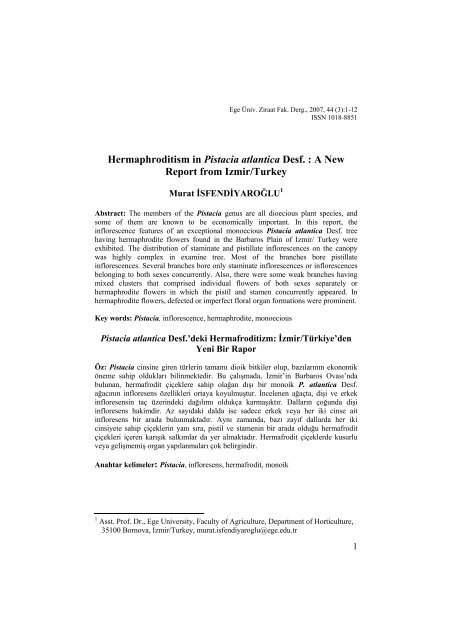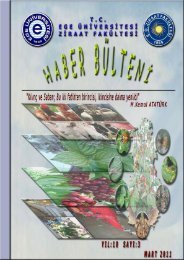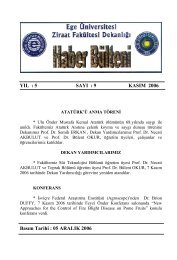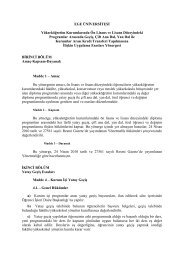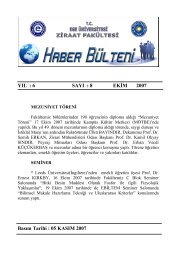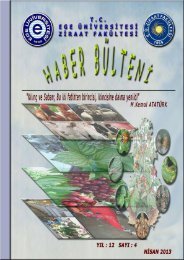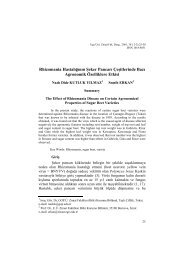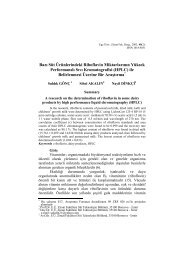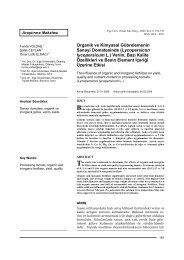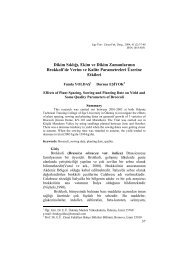Hermaphroditism in Pistacia atlantica Desf. : A New Report from ...
Hermaphroditism in Pistacia atlantica Desf. : A New Report from ...
Hermaphroditism in Pistacia atlantica Desf. : A New Report from ...
Create successful ePaper yourself
Turn your PDF publications into a flip-book with our unique Google optimized e-Paper software.
Ege Üniv. Ziraat Fak. Derg., 2007, 44 (3):1-12<br />
ISSN 1018-8851<br />
<strong>Hermaphroditism</strong> <strong>in</strong> <strong>Pistacia</strong> <strong>atlantica</strong> <strong>Desf</strong>. : A <strong>New</strong><br />
<strong>Report</strong> <strong>from</strong> Izmir/Turkey<br />
Murat İSFENDİYAROĞLU 1<br />
Abstract: The members of the <strong>Pistacia</strong> genus are all dioecious plant species, and<br />
some of them are known to be economically important. In this report, the<br />
<strong>in</strong>florescence features of an exceptional monoecious <strong>Pistacia</strong> <strong>atlantica</strong> <strong>Desf</strong>. tree<br />
hav<strong>in</strong>g hermaphrodite flowers found <strong>in</strong> the Barbaros Pla<strong>in</strong> of Izmir/ Turkey were<br />
exhibited. The distribution of stam<strong>in</strong>ate and pistillate <strong>in</strong>florescences on the canopy<br />
was highly complex <strong>in</strong> exam<strong>in</strong>e tree. Most of the branches bore pistillate<br />
<strong>in</strong>florescences. Several branches bore only stam<strong>in</strong>ate <strong>in</strong>florescences or <strong>in</strong>florescences<br />
belong<strong>in</strong>g to both sexes concurrently. Also, there were some weak branches hav<strong>in</strong>g<br />
mixed clusters that comprised <strong>in</strong>dividual flowers of both sexes separately or<br />
hermaphrodite flowers <strong>in</strong> which the pistil and stamen concurrently appeared. In<br />
hermaphrodite flowers, defected or imperfect floral organ formations were prom<strong>in</strong>ent.<br />
Key words: <strong>Pistacia</strong>, <strong>in</strong>florescence, hermaphrodite, monoecious<br />
<strong>Pistacia</strong> <strong>atlantica</strong> <strong>Desf</strong>.’deki Hermafroditizm: İzmir/Türkiye’den<br />
Yeni Bir Rapor<br />
Öz: <strong>Pistacia</strong> c<strong>in</strong>s<strong>in</strong>e giren türler<strong>in</strong> tamamı dioik bitkiler olup, bazılarının ekonomik<br />
öneme sahip oldukları bil<strong>in</strong>mektedir. Bu çalışmada, İzmir’<strong>in</strong> Barbaros Ovası’nda<br />
bulunan, hermafrodit çiçeklere sahip olağan dışı bir monoik P. <strong>atlantica</strong> <strong>Desf</strong>.<br />
ağacının <strong>in</strong>floresens özellikleri ortaya koyulmuştur. İncelenen ağaçta, dişi ve erkek<br />
<strong>in</strong>floresens<strong>in</strong> taç üzer<strong>in</strong>deki dağılımı oldukça karmaşıktır. Dalların çoğunda dişi<br />
<strong>in</strong>floresens hakimdir. Az sayıdaki dalda ise sadece erkek veya her iki c<strong>in</strong>se ait<br />
<strong>in</strong>floresens bir arada bulunmaktadır. Aynı zamanda, bazı zayıf dallarda her iki<br />
c<strong>in</strong>siyete sahip çiçekler<strong>in</strong> yanı sıra, pistil ve stamen<strong>in</strong> bir arada olduğu hermafrodit<br />
çiçekleri içeren karışık salkımlar da yer almaktadır. Hermafrodit çiçeklerde kusurlu<br />
veya gelişmemiş organ yapılanmaları çok belirg<strong>in</strong>dir.<br />
Anahtar kelimeler: <strong>Pistacia</strong>, <strong>in</strong>floresens, hermafrodit, monoik<br />
1 Asst. Prof. Dr., Ege University, Faculty of Agriculture, Department of Horticulture,<br />
35100 Bornova, Izmir/Turkey, murat.isfendiyaroglu@ege.edu.tr<br />
1
Introduction<br />
The genus <strong>Pistacia</strong> (Anacardiaceae) comprises eleven<br />
species, some of which are of high economic and cultural importance <strong>in</strong><br />
Mediterranean and Asian countries. All the species are dioecious and<br />
their flowers are unisexual, naked and anemophilous (Zohary, 1952).<br />
Both stam<strong>in</strong>ate and pistillate <strong>in</strong>florescences are panicles bear<strong>in</strong>g up to<br />
several hundred <strong>in</strong>dividual flowers. Flower buds occur laterally on oneyear<br />
old wood (Crane and Iwakiri, 1981).<br />
Up to now, very few cases were reported on exceptional<br />
gender types and flower distribution of <strong>Pistacia</strong> trees by several<br />
scientists.<br />
First, two hermaphrodite trees (with male and female organs<br />
borne <strong>in</strong> same flower) were reported <strong>in</strong> the vic<strong>in</strong>ity of Antep Prov<strong>in</strong>ce<br />
of Turkey. It was estimated that these trees were either seedl<strong>in</strong>gs of<br />
<strong>Pistacia</strong> vera, or hybrids between P. vera and P. tereb<strong>in</strong>thus (Ozbek,<br />
and Ayfer, 1958). In the second case, three trees with unusual<br />
<strong>in</strong>florescence characteristics were described as follows: (1) a branch<br />
bear<strong>in</strong>g stam<strong>in</strong>ate flowers on a female <strong>in</strong>dividual tree of P. <strong>atlantica</strong>,<br />
(2) a hybrid between P. vera and P. <strong>atlantica</strong> bear<strong>in</strong>g nearly equal<br />
numbers of pistillate and stam<strong>in</strong>ate <strong>in</strong>florescence, mostly on separate<br />
branches, and (3) a similar hybrid, predom<strong>in</strong>antly stam<strong>in</strong>ate, but with<br />
several branches bear<strong>in</strong>g pistillate <strong>in</strong>florescences (Crane, 1974).<br />
Thirdly, a group of n<strong>in</strong>e P. <strong>atlantica</strong> trees with monoecious traits were<br />
found <strong>in</strong> the Yunt Mounta<strong>in</strong>s of Manisa Prov<strong>in</strong>ce <strong>in</strong> Turkey. One of the<br />
trees was fully monoecious, i.e., all branches bore a mixture of male<br />
and female <strong>in</strong>florescences (Type I); Three of them had several branches<br />
with only stam<strong>in</strong>ate flowers, while the rest of the branches bore<br />
pistillate <strong>in</strong>florescences (Type II); Five other trees had <strong>in</strong>florescences of<br />
both sexes on several branches, and pistillate <strong>in</strong>florescences on the<br />
rema<strong>in</strong><strong>in</strong>g branches (Type III) (Kafkas et al., 2000). Recently, some<br />
monoecious P. tereb<strong>in</strong>thus trees were found <strong>in</strong> Rodopi Mounta<strong>in</strong>s of<br />
Bulgaria, a region that is quite distant <strong>from</strong> the natural distribution area<br />
of this species. The <strong>in</strong>florescence characteristics of the trees were<br />
described as follows: Male flowers were carried on one-year-old<br />
shoots, and orig<strong>in</strong>ated directly <strong>from</strong> the basal rachis; Female flowers<br />
were carried on one-year-old shoots and orig<strong>in</strong>ated about 5 cm <strong>from</strong> the<br />
peduncle <strong>in</strong>sertion; female and male flowers were present <strong>in</strong> the same<br />
<strong>in</strong>florescence (Avanzato and Quarta, 2004).<br />
The exceptional sex types of <strong>Pistacia</strong> species are of<br />
importance <strong>in</strong> relation with pistachio breed<strong>in</strong>g. It was suggested that a<br />
2
monoecious or hermaphrodite pistachio cultivar would elim<strong>in</strong>ate the<br />
need for male (poll<strong>in</strong>ator) trees <strong>in</strong> the orchard and <strong>in</strong>crease the yield per<br />
hectare by about 10% (Ozbek and Ayfer, 1958; Kafkas et al., 2000;<br />
Avanzato and Quarta, 2004). Despite, the need of a long-term<br />
conventional breed<strong>in</strong>g procedure with a number of backcrosses, the<br />
transfer of monoecious genetic trait to cultivated pistachio would be of<br />
high benefits theoretically.<br />
Anatolia is a major center of diversity for the genus <strong>Pistacia</strong>,<br />
and there are approximately 66 millions wild <strong>Pistacia</strong> trees belong<strong>in</strong>g<br />
to six taxa spread out <strong>in</strong> the four ma<strong>in</strong> geographical regions and<br />
transitional zones of Turkey (Kaska et al., 1995; Atli et al., 1998).<br />
Aegean region is also very rich and diverse <strong>in</strong> <strong>Pistacia</strong> genetic<br />
resources. In this region, the most common taxon is P. <strong>atlantica</strong>. It can<br />
be found particularly <strong>in</strong> Manisa (Yunt Mounta<strong>in</strong>s), and to a lesser<br />
extent, <strong>in</strong> Aydın, Mugla and Izmir Prov<strong>in</strong>ces (Kaska et al., 1995). In<br />
some localities, they are top-worked with pistachio cultivars.<br />
In this report, the morphological traits of a monoecious P.<br />
<strong>atlantica</strong> tree, also bear<strong>in</strong>g hermaphrodite flowers found <strong>in</strong> Barbaros<br />
Pla<strong>in</strong> of Izmir Prov<strong>in</strong>ce were presented.<br />
Materials and Methods<br />
In the course of the field observations and seed collection<br />
works, an isolated and rich population of P. <strong>atlantica</strong> trees was<br />
explored <strong>in</strong> the Barbaros Pla<strong>in</strong> about 50 km west of Izmir city.<br />
Our exam<strong>in</strong>ations on 9 April 2005 resulted <strong>in</strong> the discovery of<br />
an exceptional P. <strong>atlantica</strong> tree bear<strong>in</strong>g both stam<strong>in</strong>ate and pistillate<br />
<strong>in</strong>florescences. The exist<strong>in</strong>g tree, grow<strong>in</strong>g <strong>in</strong> an unprotected,<br />
uncultivated location was located by a GPS device (GARMIN-12) at<br />
38°19’30.6”N, 26°34’02.7”E-165 m asl.<br />
The tree, on this date, exhibited bloom<strong>in</strong>g dur<strong>in</strong>g observation.<br />
In general, pollen shedd<strong>in</strong>g started <strong>in</strong> stam<strong>in</strong>ate clusters as vegetative<br />
buds broke. Cluster distribution of both sexes on the tree appeared<br />
highly complex and variable.<br />
Shoot samples with flower clusters were collected and stored<br />
at 4 °C, under humid conditions. Dur<strong>in</strong>g dissection, flower bracts and<br />
bractlets were carefully discarded by a needle or a surgical blade for<br />
three-dimensional study of the floral organs. Micro-anatomical<br />
exam<strong>in</strong>ation of floral structures was performed with a stereo<br />
microscope (OLYMPUS SZ61), and documented with digital camera<br />
system.<br />
3
Results<br />
The tree was multi-stemmed, nearly upright and 5 m <strong>in</strong> height<br />
with a canopy spread equal to its height (Figure 1).<br />
4<br />
Figure 1. Multistemmed P. <strong>atlantica</strong> tree.<br />
Inflorescence types and distribution<br />
Observations showed the bloom<strong>in</strong>g was protandrous (male<br />
clusters bloomed about one week before female clusters).<br />
Three types of <strong>in</strong>florescences were dist<strong>in</strong>guished on branches.<br />
Male <strong>in</strong>florescence<br />
They are conical <strong>in</strong> shape, compact, later loosen<strong>in</strong>g, and<br />
reddish before pollen shedd<strong>in</strong>g. Some of them take place as unmixed<br />
clusters on several branches. Incidence of such pure branches was very<br />
scarce on the canopy. Also, male clusters have rarely coexisted with the<br />
female ones on some branches.<br />
Female <strong>in</strong>florescence<br />
Female <strong>in</strong>florescences were less conical, compact and longer<br />
than the male <strong>in</strong>florescences. They were yellowish-green <strong>in</strong> colour, the<br />
perianth conta<strong>in</strong>ed a s<strong>in</strong>gle lanceolate and hairy bract with several<br />
sepals. Stigmas were prom<strong>in</strong>ent, bright p<strong>in</strong>k, unequally long and<br />
strongly recurved. Female clusters occur on one-year old wood like<br />
male clusters. Female clusters were located mostly on the outer canopy<br />
and generally but not always, unmixed (Figure 2).
m<br />
Figure 2. Female and male clusters on one-year old wood, f: female, m: male,<br />
bar=1 cm<br />
Mixed <strong>in</strong>florescence<br />
The mixed <strong>in</strong>florescence was more similar <strong>in</strong> appearance to<br />
the female <strong>in</strong>florescence as opposed to the male. The mixed<br />
<strong>in</strong>florescence was conical, compact <strong>in</strong> shape and light green <strong>in</strong> color.<br />
Occurrence of mixed clusters orig<strong>in</strong>ated <strong>from</strong> one-year old wood of the<br />
weak lateral branches <strong>in</strong> a narrow part of the canopy on the south side<br />
of the tree (Figure 3).<br />
The mixed <strong>in</strong>florescences occurred mostly unmixed with other<br />
types (Figure 4), but rarely appeared with male clusters on several<br />
branches (Figure 5). Organ morphology of the mixed <strong>in</strong>florescences<br />
occurr<strong>in</strong>g on the same branch with male <strong>in</strong>florescences was complex<br />
and uneven.<br />
Floral structure of mixed <strong>in</strong>florescence<br />
The mixed clusters not only comprised the <strong>in</strong>dividual flowers<br />
of both sexes separately, but also bore hermaphrodite flowers <strong>in</strong> which<br />
the pistil and stamen concurrently occurred (Figure 6).<br />
In general, pistillate flower formation was predom<strong>in</strong>ant <strong>in</strong><br />
mixed clusters, whereas the number of stam<strong>in</strong>ate and hermaphrodite<br />
flowers was rather low. However, the occurrence of stam<strong>in</strong>ate flowers<br />
was more frequent <strong>in</strong> several clusters.<br />
f<br />
m<br />
m<br />
5
6<br />
f<br />
f<br />
f<br />
mx<br />
Figure 3. Female and mixed clusters on canopy, f: female, mx: mixed.<br />
Figure 4. Mixed clusters on one-year old wood, bar=1 cm<br />
In mixed clusters, defected or imperfect floral organ formation<br />
was highly extensive. Individual male flowers on lateral branches<br />
generally carried one or rarely two anthers <strong>in</strong> contrast to normal male<br />
flowers which had more anthers. On the other hand, anther formation<br />
was usually more or less defected <strong>in</strong> shape or at least one of the two<br />
anthers was even rudimentary <strong>in</strong> stam<strong>in</strong>ate flowers. It was observed<br />
that some clusters bore more stam<strong>in</strong>ate flowers than usual and have<br />
more anthers. Such flowers had a lot of malformed and rudimentary<br />
anthers, besides some pistil-like odd structures as well (Figure 7).
Figure 5. Male and mixed cluster on one-year old wood, m: male, mx: mixed,<br />
bar=1 cm<br />
Figure 6. Floral structure of mixed <strong>in</strong>florescence, h: hermaphrodite, p: pistillate,<br />
s: stam<strong>in</strong>ate flower, bar=1mm<br />
As for the pistillate flowers, uneven pistil formations were<br />
frequently detected. Unlike the globular shaped ovaries <strong>in</strong> normal<br />
pistils, asymmetrically halved or cyl<strong>in</strong>drical ovaries with over split or<br />
closed stigmas were common (Figure 8). Double ovaries were rarely<br />
observed <strong>in</strong> some pistillate flowers.<br />
In hermaphrodite flowers, malformation of floral organs was<br />
more prom<strong>in</strong>ent than unisexual flowers. Most of them have one anther<br />
and a pistil is contiguous with each other. On the other hand, anther<br />
numbers of the flowers were markedly high on the term<strong>in</strong>al po<strong>in</strong>t of<br />
clusters.<br />
mx<br />
h p s<br />
h<br />
m<br />
7
Figure 7. Malformed organs <strong>in</strong> stam<strong>in</strong>ate flower, a: anther, pl: pistil-like structure,<br />
ra: rudimentary anther, bar=500µ<br />
Figure 8. Abnormal pistil formations, cy: cyl<strong>in</strong>dirical, ha: halved and no: normal<br />
ovary, cs: closed stigma, bar=1 mm<br />
In such flowers, a rudimentary or less developed pistil was<br />
surrounded by several anthers (Figure 9). Defected pistil formation was<br />
more prom<strong>in</strong>ent than stamen formation <strong>in</strong> hermaphrodite flowers.<br />
Ovaries were asymmetrically elongated, nearly halved rather than<br />
globular shape. Stigmas were unequal. Anthers were not well<br />
developed or formed as those observed <strong>in</strong> usual stam<strong>in</strong>ate flowers.<br />
Some of the anthers have stigmas or stigma-like structures (Figure 10).<br />
8<br />
pl<br />
a<br />
cs cy<br />
no<br />
ha<br />
ra
p<br />
Figure 9. Term<strong>in</strong>al hermaphrodite flower, a: anther, p: pistil, bar=500µ<br />
sl<br />
a<br />
Figure 10. Floral organs <strong>in</strong> hermaphrodite flower, a: anther, s: stigma, sl: stigma–like<br />
structure, o: ovary, bar=500µ<br />
Discussion<br />
Observations showed the exam<strong>in</strong>ed tree was multi stemmed<br />
and quite small contrasted with the general appearance of the other P.<br />
<strong>atlantica</strong> <strong>in</strong>dividuals scattered over the area. The tree appears to have<br />
orig<strong>in</strong>ated <strong>from</strong> sucker regrowth after the orig<strong>in</strong>al tree was cut down at<br />
some time <strong>in</strong> the past. In fact, <strong>in</strong>tact P. <strong>atlantica</strong> trees <strong>in</strong> this area have<br />
one stem and generally a very large habit.<br />
At the time of bloom<strong>in</strong>g, growth and development of male and<br />
female clusters were not synchronous. The tree seemed to have<br />
protandrous dicogamy and male clusters bloomed about one week<br />
before female ones. Protandrous P. <strong>atlantica</strong> trees were observed<br />
previously (Grundwag, 1975; Kafkas et al., 2000).<br />
Morphological exam<strong>in</strong>ations showed the presence of three<br />
different <strong>in</strong>florescence types with diverse distribution patterns on<br />
s<br />
o<br />
a<br />
9
anches. Male <strong>in</strong>florescences were differed <strong>from</strong> female<br />
<strong>in</strong>florescences with their different morphology. However, general<br />
morphology of <strong>in</strong>florescences belong<strong>in</strong>g to both sexes matched with the<br />
f<strong>in</strong>d<strong>in</strong>gs of previous studies on P. <strong>atlantica</strong> trees (Zohary, 1952;<br />
Grundwag, 1976). On the other hand, female clusters occurred on oneyear<br />
old wood like the male ones. They were located predom<strong>in</strong>antly on<br />
the outer canopy as unmixed branches. Also, they have rarely coexisted<br />
with male clusters on some branches (Figure 2). This type of<br />
<strong>in</strong>florescence distribution was also reported for the Type II and Type III<br />
trees found <strong>in</strong> the Yunt Mounta<strong>in</strong>s <strong>in</strong> which the pistillate cluster was<br />
predom<strong>in</strong>ant (Kafkas et al., 2000).<br />
As for the mixed <strong>in</strong>florescences, they rather resemble female<br />
<strong>in</strong>florescences or exhibit an <strong>in</strong>termediate morphology between the<br />
<strong>in</strong>florescences belong<strong>in</strong>g to both sexes. Occurrence of such clusters<br />
was limited to a narrow part of the canopy on the south side (Figure 3).<br />
The mixed <strong>in</strong>florescences were born on one-year old wood as unmixed<br />
<strong>in</strong> general, but they rarely occurred together with male ones on several<br />
branches.<br />
The degree of growth and development <strong>in</strong> mixed clusters<br />
appeared to be less than those found <strong>in</strong> female ones at the time of<br />
sampl<strong>in</strong>g. It was thought that the occurrence of such mixed clusters<br />
might partially l<strong>in</strong>k with either different source allocation with<strong>in</strong> the<br />
tree or position of bear<strong>in</strong>g branches on the canopy.<br />
In this work, the presence of hermaphrodite flowers <strong>in</strong> mixed<br />
clusters was also shown. Hermaphrodite flowers were formerly<br />
reported <strong>in</strong> an early work <strong>in</strong> P. vera (Ozbek and Ayfer, 1958) and<br />
recently <strong>in</strong> P. tereb<strong>in</strong>thus (Avanzato and Quarta, 2004). But micromorphology<br />
of floral structures had not exhibited <strong>in</strong> both cases. Apart<br />
<strong>from</strong> unusual hermaphrodite flowers, malformed floral organs<br />
frequently occurred <strong>in</strong> mixed clusters. For <strong>in</strong>stance, anther numbers of<br />
<strong>in</strong>dividual male flowers on mixed clusters did not exceed two, while<br />
the male flowers of normal <strong>in</strong>florescences had more anthers. As a<br />
matter of fact, stamen number that ranged between 5 and 7 was<br />
reported <strong>in</strong> male flowers of P. <strong>atlantica</strong> (Zohary, 1952).<br />
Exam<strong>in</strong>ations also showed that uneven organ formations were<br />
highly extensive <strong>in</strong> pistillate flowers of mixed <strong>in</strong>florescences (Figure<br />
8). Moreover, double ovary formation was also detected <strong>in</strong> some<br />
pistillate flowers. Double ovary formation was not reported for the<br />
members of <strong>Pistacia</strong> so far. It is an unacceptable characteristic for nut<br />
crops <strong>from</strong> the pomological po<strong>in</strong>t of view.<br />
10
Organ formation disorders were more expressed <strong>in</strong><br />
hermaphrodite flowers than unisexual ones. But defected or<br />
rudimentary pistillate structures were more abundant than the stam<strong>in</strong>ate<br />
ones <strong>in</strong> this type of flowers was observed. Post-poll<strong>in</strong>ation studies also<br />
showed the ovules of most hermaphrodite flowers were not perfect and<br />
ma<strong>in</strong> structures were uneven compared to normal pistillate flowers.<br />
Conclusion<br />
Results of this study proved the floral morphology of<br />
monoecious P. <strong>atlantica</strong> was far more complex. Former reports on the<br />
unusual gender types <strong>in</strong> <strong>Pistacia</strong> generally emphasized the various<br />
cases of <strong>in</strong>florescence distribution without regard<strong>in</strong>g the micromorphology<br />
of floral structures. However, our exam<strong>in</strong>ations did expose<br />
that the <strong>in</strong>cidence of defected or rudimentary floral organ formations<br />
could reach to a large extent <strong>in</strong> a monoecious <strong>Pistacia</strong> tree. In general,<br />
the expression of monoecious traits may give rise to hermaphroditism<br />
together with malformation of floral structures <strong>in</strong> P. <strong>atlantica</strong>. In<br />
pistachio breed<strong>in</strong>g, mentioned problems of floral biology would more<br />
or less affect the f<strong>in</strong>al yield. So they have to be considered as potential<br />
risks <strong>in</strong> transferr<strong>in</strong>g the monoecious traits.<br />
Our works will more focus on the clarification of <strong>in</strong>florescence<br />
characteristics and breed<strong>in</strong>g value of exam<strong>in</strong>ed tree <strong>in</strong> the com<strong>in</strong>g<br />
years.<br />
References<br />
Atli, H.S., S. Arpaci, N. Kaska, and H. Ayanoglu. 1998. Wild <strong>Pistacia</strong> species <strong>in</strong><br />
Turkey. 35-40. <strong>Report</strong> of the IPGRI Workshop, 14-17 December 1998, Irbid,<br />
Jordan. S. Padulosi and Hadj-Hassan (Eds.). 105p.<br />
Avanzato, D., and R. Quarta. 2004. Monoecious <strong>Pistacia</strong> tereb<strong>in</strong>thus found <strong>in</strong><br />
Bulgaria. Crop Wild Relative, 2: 14-16.<br />
Crane, J.C. 1974. <strong>Hermaphroditism</strong> <strong>in</strong> <strong>Pistacia</strong>. Calif. Agric., 28: 3-4.<br />
Crane, J.C., and B.T. Iwakiri. 1981. Morphology and reproduction of pistachio. Hort.<br />
Rev. 3: 376-393.<br />
Grundwag, M. 1975. Seed set <strong>in</strong> some <strong>Pistacia</strong> L. (Anacardiaceae) species after<br />
<strong>in</strong>ter-and <strong>in</strong>traspesific poll<strong>in</strong>ation. Isr. Jour. Bot. 24:205-211.<br />
Grundwag, M. 1976. Embryology and fruit development <strong>in</strong> four species of <strong>Pistacia</strong> L.<br />
(Anacardiaceae). Botanical Journal of the L<strong>in</strong>nean Society, 73:355-370.<br />
Kafkas, S., R. Pearl-Treves, and N. Kaska. 2000. Unusual <strong>Pistacia</strong> <strong>atlantica</strong> <strong>Desf</strong>.<br />
(Anacardiaceae) monoecious sex type <strong>in</strong> the Yunt Mounta<strong>in</strong>s of the Manisa<br />
Prov<strong>in</strong>ce of Turkey. Isr. Jour. of Plant Sci. 48:277-280.<br />
Kaska, N., S. Caglar, and S. Kafkas. 1995. Genetic diversity and germplasm<br />
conservation of <strong>Pistacia</strong> species <strong>in</strong> Turkey. Taxonomy, distribution,<br />
conservation and uses of <strong>Pistacia</strong> genetic resources. 46-50. <strong>Report</strong> of the<br />
11
IPGRI Workshop, 29-30 June 1995, Palermo, Italy. S. Padulosi, T. Caruso and<br />
E. Barone (Eds.). 69p.<br />
Ozbek, S., and M. Ayfer. 1958. A hermaphroidite <strong>Pistacia</strong> found <strong>in</strong> the vic<strong>in</strong>ity of<br />
Antep. Turkey. Proc. Amer. Soc. Hort. Sci. 72:240-241.<br />
Zohary, M. 1952. A monographical study of the genus <strong>Pistacia</strong>. Palest. J. Bot.,<br />
Jerusalem Series 5:187-228.<br />
12


